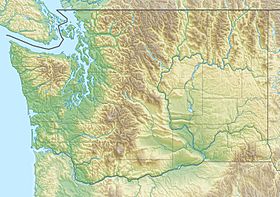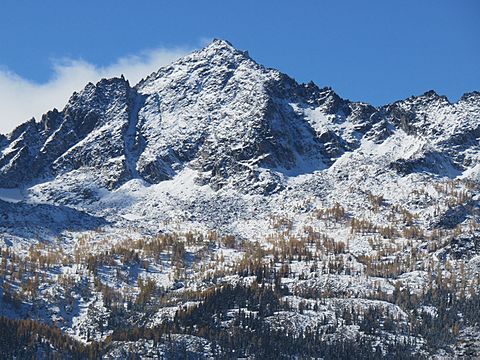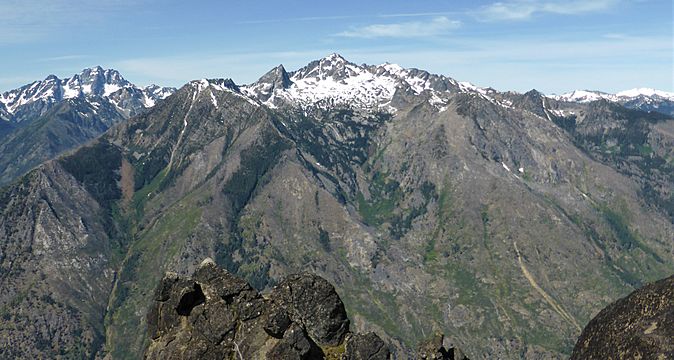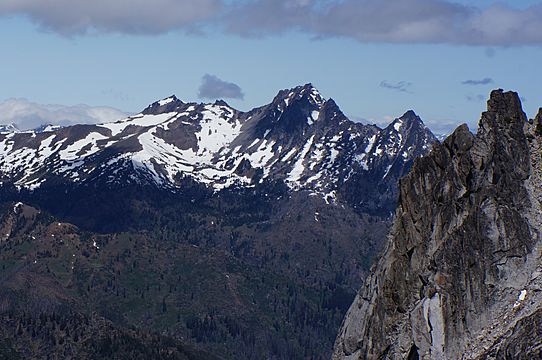Cashmere Mountain facts for kids
Quick facts for kids Cashmere Mountain |
|
|---|---|
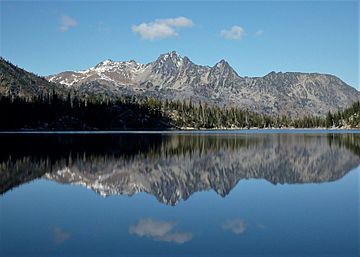
Cashmere Mountain reflected in Colchuck Lake
|
|
| Highest point | |
| Elevation | 8,501 ft (2,591 m) |
| Prominence | 1,581 ft (482 m) |
| Isolation | 4.4 mi (7.1 km) |
| Parent peak | Cannon Mountain (8,638 ft) |
| Geography | |
| Location | Chelan County Washington state, U.S. |
| Parent range | Cascade Range |
| Topo map | USGS Cashmere Mountain |
| Climbing | |
| First ascent | 1900 Robert A. Farmer (USGS) |
| Easiest route | class 3 Scrambling |
Cashmere Mountain is a tall peak in Washington state. It stands 8,501-foot (2,591-metre) high. You can find it in Chelan County.
This mountain is located within the beautiful Alpine Lakes Wilderness. This special area is managed by the Okanogan-Wenatchee National Forest. Cashmere Mountain is part of the Wenatchee Mountains. These mountains are a smaller group within the much larger Cascade Range.
The closest taller mountain to Cashmere Mountain is Cannon Mountain. It is about 4.4 mi (7.1 km) to the southeast. Rain and melting snow from Cashmere Mountain flow into Icicle Creek. This creek then joins the Wenatchee River.
Weather Around Cashmere Mountain
Most of the weather that affects Cashmere Mountain starts far away. It begins over the Pacific Ocean. These weather systems then travel east. When they reach the tall Cascade Mountains, they are forced to rise.
As the air rises, it cools down. This causes the moisture in the air to turn into rain or snow. This process is called Orographic lift. Because of this, the Cascade Mountains get a lot of rain and snow. This is especially true during the winter months.
In winter, the weather is often cloudy. But in summer, high pressure systems form over the Pacific Ocean. These systems usually bring clear skies. So, there is often little or no cloud cover during the summer.
How the Mountains Were Formed
The Alpine Lakes Wilderness has some very rugged land. You can see jagged peaks and sharp ridges. There are also deep valleys carved by glaciers. Plus, there are huge granite walls. Over 700 mountain lakes dot the landscape.
Long, long ago, amazing geological events happened. These events created the varied land and huge changes in height across the Cascade Range. These changes also led to the different climates we see today.
The Cascade Mountains started forming millions of years ago. This was during a time called the late Eocene Epoch. At that time, the North American Plate was slowly moving over the Pacific Plate. This movement caused many volcanic eruptions.
Also, small pieces of the Earth's crust, called terranes, crashed into North America. These collisions helped build the North Cascades about 50 million years ago.
Later, during the Pleistocene period, glaciers played a big role. This was over two million years ago. Huge sheets of ice moved forward and then melted back many times. As they moved, they scraped away the land. They left behind piles of rock and dirt.
The last glaciers in the Alpine Lakes area started melting about 14,000 years ago. By 10,000 years ago, they had moved north of the Canada–US border. The river valleys in the area have a U-shape. This shape was created by these recent glaciers.
The mountains also got taller due to uplift. This is when the Earth's crust pushes upwards. Also, faulting, which is when parts of the Earth's crust slide past each other, helped shape the land. These processes, along with glaciation, created the tall peaks and deep valleys of the Alpine Lakes Wilderness.
Gallery
Images for kids


